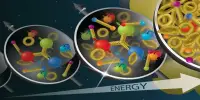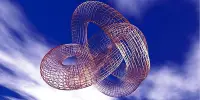The amount of information contained in a book is determined by its volume, not by the size of the book’s cover. However, in the quantum world, information is frequently linked to surface area. This strange and counter-intuitive fact was predicted theoretically years ago, but it has only recently been measured: ‘Mutual quantum information’ scales with surface, not volume.
Some things are connected, while others are not. Assume you choose a person at random from a crowd who is significantly taller than the average. In that case, they will almost certainly weigh more than the average. One quantity statistically contains some information about the other.
Quantum physics enables even stronger connections between quantities: different particles or parts of a large quantum system can “share” a certain amount of information. There are some interesting theoretical predictions about this: surprisingly, the measure of this “mutual information” does not depend on the system’s size, but only on its surface. This unexpected finding was confirmed experimentally at the TU Wien and published in Nature Physics. The Max-Planck-Institut für Quantenoptik in Garching, FU Berlin, ETH Zürich, and New York University contributed theoretical input to the experiment and its interpretation.
The experiment is very challenging. We require as much information about our quantum system as quantum physics allows. We developed a unique tomography technique for this purpose. We obtain the information we require by slightly perturbing the atoms and then observing the resulting dynamics.
Jörg Schmiedmayer
Quantum information: More strongly connected than classical physics allows
“Imagine a gas container in which small particles fly around and behave in a very classical way like small spheres,” says first author Mohammadamin Tajik of the Vienna Center for Quantum Science and Technology (VCQ) – Atominstitut of TU Wien. “If the system is in equilibrium, particles in different areas of the container have no knowledge of one another.” They can be considered completely independent of one another. As a result, the mutual information these two particles share is zero.”
However, in the quantum world, things are different: if particles behave quantumly, they may no longer be considered independently of one another. They are mathematically connected – you can’t meaningfully describe one particle without saying something about the other.
“For such cases, there has long been a prediction about the mutual information shared between different subsystems of a many-body quantum system,” Mohammadamin Tajik explains. “In such a quantum gas, the shared mutual information is greater than zero, and it is independent of subsystem size – but only of the subsystem’s outer bounding surface.”
This prediction appears to be intuitively strange: it is not in the classical world. For example, the information contained in a book is determined by its volume rather than the size of the book’s cover. However, in the quantum world, information is frequently linked to surface area.

Measurements with ultracold atoms
An international research team led by Prof. Jörg Schmiedmayer has now confirmed for the first time that the mutual information in a many body quantum system scales with the surface area rather than with the volume. For this purpose, they studied a cloud of ultracold atoms. The particles were cooled to just above absolute zero temperature and held in place by an atom chip.
The quantum properties of the particles become increasingly important at extremely low temperatures. The information spreads throughout the system, and the connection between the individual parts of the overall system becomes increasingly important. A quantum field theory can be used to describe the system in this case.
“The experiment is very challenging,” Jörg Schmiedmayer says. “We require as much information about our quantum system as quantum physics allows.” We developed a unique tomography technique for this purpose. We obtain the information we require by slightly perturbing the atoms and then observing the resulting dynamics. It’s like throwing a rock into a pond and then reading the waves to learn about the state of the liquid and the pond.”
This “shared information” has a limited range as long as the system’s temperature does not reach absolute zero (which is impossible). This is related to the “coherence length” in quantum physics, which indicates the distance to which particles quantumly behave similarly and thus know from each other. “This also explains why shared information doesn’t matter in a classical gas,” Mohammadamin Tajik explains. “In a classical many-body system, coherence vanishes; the particles no longer know anything about their neighbors.” The experiment also confirmed the effect of temperature and coherence length on mutual information.
Quantum information plays an essential role in many technical applications of quantum physics today. Thus, the experiment results are relevant to various research areas — from solid-state physics to the quantum physical study of gravity.
















